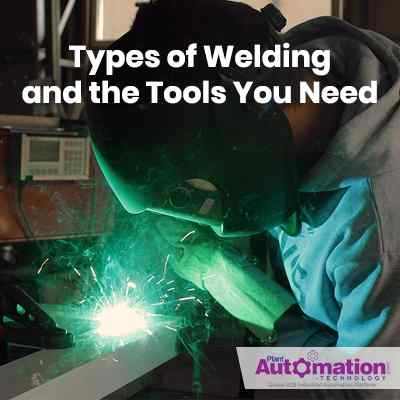Types of Welding and the Tools You Need

Welding is the process of joining two or more pieces of metal to make them together with the application of heat. Sometimes, a filler material is adjoined to ease the progress of coalescence. The assembled parts that are joined using welding process are called weldments. Welding is primarily used in metal parts and their alloys.
Welding processes are classified into two major groups:
1. Fusion welding: In fusion welding process, heat is used to melt base metal. Often, in this process, a filler metal is added to the molten pool to facilitate the process and provide bulk and strength to the joint.
Commonly used fusion welding processes are: arc welding, resistance welding, oxyfuel welding, electron beam welding, and laser beam welding.
2. Solid-state welding: In this process, pressure or a combination of heat and pressure is used to join parts. No filler metal is used.
Commonly used solid-state welding processes are: diffusion welding, friction welding, ultrasonic welding.
Here are some of the types of welding process that are widely used in the industry:
1) SMAW: Shielded Metal Arc Welding
Shielded Metal Arc Welding (SMAW) is an arc welding process wherein coalescence is produced by heating the workpiece with an electric arc setup between a flux-coated electrode and the workpiece. The electrode is in a rod form coated with flux.
Other Names: Manual Metal Arc Welding (MMAW), Flex Shielded Arc Welding, Stick Welding
SMAW is used in construction, steel fabrication, pipeline work and for heavy equipments. SMAW is one of the preferred processes as it works great on most metals, allows for welding thick materials, provides efficiency and it is included with low maintenance cost.
These reasons makes it an excellent joining process for most industrial construction needs. It is mostly used to weld copper, iron, aluminium, nickel.
An electrode (which looks like a stick) is made of metal with a flux coating on the outside. It protects the weld area from the air while the rod is burning. Electrodes are covered with flux, which is an important factor in improving the quality of weld and providing arc stability.
Advantages of SMAW
1) Shielded Metal Arc Welding (SMAW) can work on rough surfaces
2) Tools used in this process are less expensive and portable
3) It can be used comfortably with outdoor applications
4) SMAW is an easy process that offers more efficiency
5) It can be used for a range of metal types of various thickness
Disadvantages:
1)SMAW cannot be used with reactive metals such as titanium, zirconium
2) More skills are required to perform this process
3) It is not an automated process, so the productivity is less than other welding processes
Applications
1) It is dominantly used in industrial fabrication industries.
2) Stick welding is used in repair companies.
3) It is used in the construction of steel structures and in the welding process of cast iron and ductile iron.
4) SMAW is used in pipelines, ship building, construction, farm machinery, underwater welding
2. GMAW: Gas Metal Arc Welding
Gas Metal Arc Welding (GMAW) is a high-speed, economical process in which the heat for melting the metal is generated by an electric arc between a consumable electrode and the metal.
Other Names: Metal Inert Gas(MIG), Gas Metal Arc Welding
In this process, inert gases such as helium, argon, carbon dioxide or a mixture of them are used to prevent atmospheric contamination of the weld. The weld gum is used to allow the flow of the shielding gas. The electrode used here is in a wire form, fed continuously at a fixed rate. The wire is consumed during the process and thereby provides filler metal.
This type of welding is easy to implement, learn and can be used on a wide range of metals. It is typically used in factories where high production is needed.
Advantages
1. Gas Metal Arc Welding (GMAW) is a faster welding process.
2. It provides better weld pool visibility
3. This process can be learned and automated easily
4. It is clean and efficient welding process
Disadvantages
• It involves high maintenance cost as more electronic equipments are used
• It is not suitable for outdoor welding
• Thick metals cannot be welded using this process
• Its initial setup cost is high
Applications
The GMAW or MIG welding process are mostly used in automotive industries and pipe industries, building bridges and in the repair work.
3. FCAW: Flux Cored Arc Welding
Flux Cored Arc Welding (FCAW) is a semi-automatic or automatic arc welding process. It is similar to MIG welding. These processes use wire feeds, and similar equipments.
FCAW requires continuously fed tubular electrode containing flux and a constant current welding power supply. This means that FCAW makes use of a tubular wide that is filled with a flux. The arc will be started from the electrode to the job.
The flux which is filled in electrode melts during welding process and shields the welded area from the atmosphere. Direct current, electrode positive are used in FCAW.
Flux Cored Arc Welding (FCAW) is mainly used due to its speed and higher electrode efficiency. FCAW is typically used in shipyards or anywhere that needs lots of welding to be done on thick metals.
Advantages:
• High deposition rate
• Porosity chances are very low
• Less cleaning of metal is required
• No shielding gas needed for some wires suitable in windy conditions
Disadvantages:
• More smoke comes out as compared to other processes like GMAW and SAW
• Wire is more expensive
• Equipment is expensive and complex
Applications:
• Flux Cored Arc Welding (FCAW) is extensively used in ship building industry as it saves labor costs.
• This process is frequently used in construction industries for welding purposes
4. GTAW: Gas Tungsten Arc Welding
Gas Tungsten Arc Welding (GTAW) is a joining technology that uses a constant current power supply just like Stick welding. This process uses a torch that contains tungsten to produce an arc.
GTAW produces the weld using a non-consumable tungsten electrode. Inert gases such as helium or argon are used to protect the area from being welded from contamination, and also filler metal is used.
A column of plasma is produced through a constant-current welding power supply and it is used to conduct energy across the arc.
GTAW is a cleaner method in which it does not require a welding slag, and a neat, attractive appearance is important.
TIG welding is used for welding exotic metals or anywhere that requires high quality welds. This process is one of the most difficult types of welding to learn.
Other Names: It is also known as TIG- Tungsten Inert Gas, HerliArc
Advantages:
• It is used for numerous metals: steel, bronze, nickel, brass, copper etc
• It produces welds without sparks, smoke or fumes
• It can be used on thin and thick metals
• GTAW is good for applications that require an attractive appearance
• It can be used for detailed designs and curves
Applications:
GTAW is used in:
• Aerospace industry
• Automotive, Construction
• Ship fitting
• For repairs











